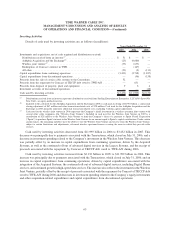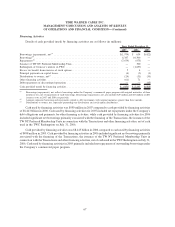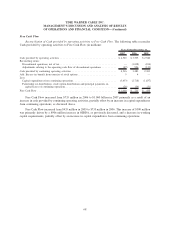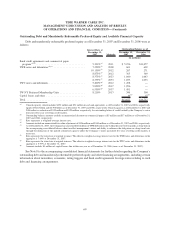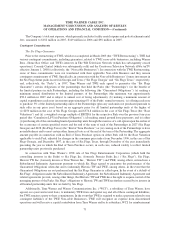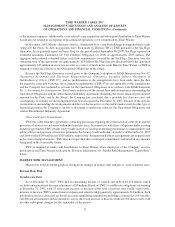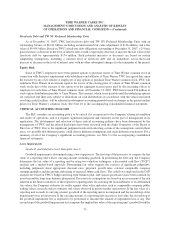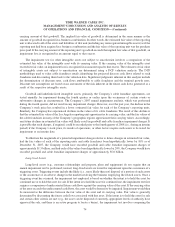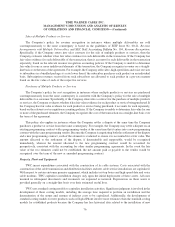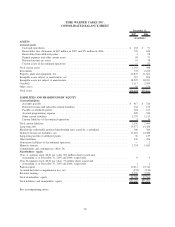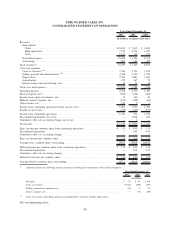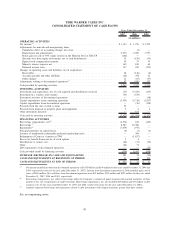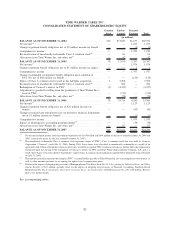Time Warner Cable 2007 Annual Report Download - page 80
Download and view the complete annual report
Please find page 80 of the 2007 Time Warner Cable annual report below. You can navigate through the pages in the report by either clicking on the pages listed below, or by using the keyword search tool below to find specific information within the annual report.asset’s carrying value to its fair value. To the extent the carrying value is greater than the asset’s fair value, an
impairment loss is recognized for the difference.
Significant judgments in this area involve determining whether a triggering event has occurred, determining
the future cash flows for the assets involved and determining the proper discount rate to be applied in determining
fair value. In 2007, there were no significant long-lived asset impairments.
Multiple-element Transactions
Multiple-element transactions involve situations where judgment must be exercised in determining the fair
value of the different elements in a bundled transaction. As the term is used here, multiple-element arrangements
can involve:
• Contemporaneous purchases and sales (e.g., the Company sells advertising services to a customer and at
the same time purchases programming services);
• Sales of multiple products and/or services (e.g., the Company sells video, high-speed data and voice
services to a customer); and/or
• Purchases of multiple products and/or services, or the settlement of an outstanding item contemporaneous
with the purchase of a product or service (e.g., the Company settles a dispute on an existing programming
contract at the same time that it enters into a new programming contract with the same programming
vendor).
Contemporaneous Purchases and Sales
In the normal course of business, TWC enters into multiple-element transactions where the Company is
simultaneously both a customer and a vendor with the same counterparty. For example, when negotiating the terms
of programming purchase contracts with cable networks, TWC may at the same time negotiate for the sale of
advertising to the same cable network. Arrangements, although negotiated contemporaneously, may be documented
in one or more contracts. In accounting for such arrangements, the Company looks to the guidance contained in the
following authoritative literature:
• Accounting Principles Board Opinion No. 29, Accounting for Nonmonetary Transactions;
• FASB Statement No. 153, Exchanges of Nonmonetary Assets—an amendment of APB Opinion No. 29;
• Emerging Issues Task Force (“EITF”) Issue No. 01-9, Accounting for Consideration Given by a Vendor to a
Customer; and
• EITF Issue No. 02-16, Accounting by a Customer (Including a Reseller) for Certain Consideration
Received from a Vendor (“EITF 02-16”).
The Company’s accounting policy for each transaction negotiated contemporaneously is to record each
element of the transaction based on the respective estimated fair values of the products or services purchased and the
products or services sold. The judgments made in determining fair value in such transactions impact the amount of
revenues, expenses and net income recognized over the respective terms of the transactions, as well as the respective
periods in which they are recognized.
In determining the fair value of the respective elements, TWC refers to quoted market prices (where available),
historical transactions or comparable cash transactions. The most frequent transactions of this type that the
Company encounters involve funds received from its vendors, which the Company accounts for in accordance with
EITF 02-16. The Company records cash consideration received from a vendor as a reduction in the price of the
vendor’s product unless (i) the consideration is for the reimbursement of a specific, incremental, identifiable cost
incurred in which case it would record the cash consideration received as a reduction in such cost or (ii) the
Company is providing an identifiable benefit in exchange for the consideration in which case it recognizes revenue
for this element.
75
TIME WARNER CABLE INC.
MANAGEMENT’S DISCUSSION AND ANALYSIS OF RESULTS
OF OPERATIONS AND FINANCIAL CONDITION—(Continued)


